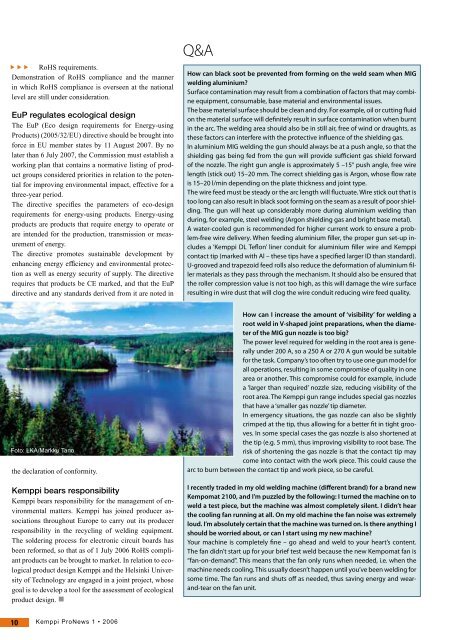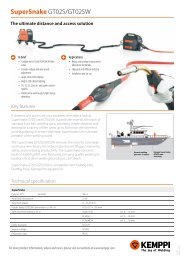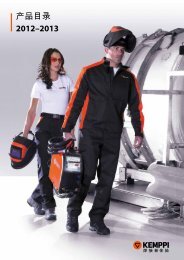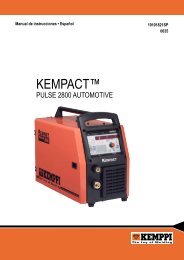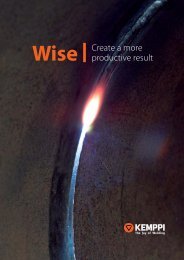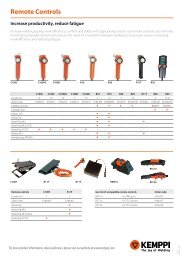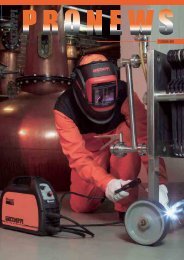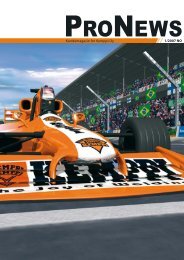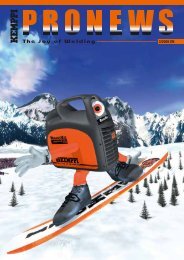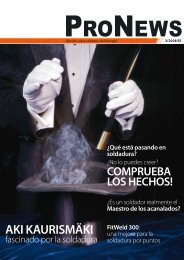ProNews_1_06_EN.pdf - Kemppi
ProNews_1_06_EN.pdf - Kemppi
ProNews_1_06_EN.pdf - Kemppi
Create successful ePaper yourself
Turn your PDF publications into a flip-book with our unique Google optimized e-Paper software.
RoHS requirements.<br />
Demonstration of RoHS compliance and the manner<br />
in which RoHS compliance is overseen at the national<br />
level are still under consideration.<br />
EuP regulates ecological design<br />
The EuP (Eco design requirements for Energy-using<br />
Products) (2005/32/EU) directive should be brought into<br />
force in EU member states by 11 August 2007. By no<br />
later than 6 July 2007, the Commission must establish a<br />
working plan that contains a normative listing of product<br />
groups considered priorities in relation to the potential<br />
for improving environmental impact, effective for a<br />
three-year period.<br />
The directive specifies the parameters of eco-design<br />
requirements for energy-using products. Energy-using<br />
products are products that require energy to operate or<br />
are intended for the production, transmission or measurement<br />
of energy.<br />
The directive promotes sustainable development by<br />
enhancing energy efficiency and environmental protection<br />
as well as energy security of supply. The directive<br />
requires that products be CE marked, and that the EuP<br />
directive and any standards derived from it are noted in<br />
Q&A<br />
How can black soot be prevented from forming on the weld seam when MIG<br />
welding aluminium<br />
Surface contamination may result from a combination of factors that may combine<br />
equipment, consumable, base material and environmental issues.<br />
The base material surface should be clean and dry. For example, oil or cutting fluid<br />
on the material surface will definitely result in surface contamination when burnt<br />
in the arc. The welding area should also be in still air, free of wind or draughts, as<br />
these factors can interfere with the protective influence of the shielding gas.<br />
In aluminium MIG welding the gun should always be at a push angle, so that the<br />
shielding gas being fed from the gun will provide sufficient gas shield forward<br />
of the nozzle. The right gun angle is approximately 5 –15° push angle, free wire<br />
length (stick out) 15–20 mm. The correct shielding gas is Argon, whose flow rate<br />
is 15–20 l/min depending on the plate thickness and joint type.<br />
The wire feed must be steady or the arc length will fluctuate. Wire stick out that is<br />
too long can also result in black soot forming on the seam as a result of poor shielding.<br />
The gun will heat up considerably more during aluminium welding than<br />
during, for example, steel welding (Argon shielding gas and bright base metal).<br />
A water-cooled gun is recommended for higher current work to ensure a problem-free<br />
wire delivery. When feeding aluminium filler, the proper gun set-up includes<br />
a ‘<strong>Kemppi</strong> DL Teflon’ liner conduit for aluminium filler wire and <strong>Kemppi</strong><br />
contact tip (marked with Al – these tips have a specified larger ID than standard).<br />
U-grooved and trapezoid feed rolls also reduce the deformation of aluminium filler<br />
materials as they pass through the mechanism. It should also be ensured that<br />
the roller compression value is not too high, as this will damage the wire surface<br />
resulting in wire dust that will clog the wire conduit reducing wire feed quality.<br />
Foto: LKA/Markku Tano<br />
the declaration of conformity.<br />
<strong>Kemppi</strong> bears responsibility<br />
<strong>Kemppi</strong> bears responsibility for the management of environmental<br />
matters. <strong>Kemppi</strong> has joined producer associations<br />
throughout Europe to carry out its producer<br />
responsibility in the recycling of welding equipment.<br />
The soldering process for electronic circuit boards has<br />
been reformed, so that as of 1 July 20<strong>06</strong> RoHS compliant<br />
products can be brought to market. In relation to ecological<br />
product design <strong>Kemppi</strong> and the Helsinki University<br />
of Technology are engaged in a joint project, whose<br />
goal is to develop a tool for the assessment of ecological<br />
product design. •<br />
How can I increase the amount of ‘visibility’ for welding a<br />
root weld in V-shaped joint preparations, when the diameter<br />
of the MIG gun nozzle is too big<br />
The power level required for welding in the root area is generally<br />
under 200 A, so a 250 A or 270 A gun would be suitable<br />
for the task. Company’s too often try to use one gun model for<br />
all operations, resulting in some compromise of quality in one<br />
area or another. This compromise could for example, include<br />
a ‘larger than required’ nozzle size, reducing visibility of the<br />
root area. The <strong>Kemppi</strong> gun range includes special gas nozzles<br />
that have a ‘smaller gas nozzle’ tip diameter.<br />
In emergency situations, the gas nozzle can also be slightly<br />
crimped at the tip, thus allowing for a better fit in tight grooves.<br />
In some special cases the gas nozzle is also shortened at<br />
the tip (e.g. 5 mm), thus improving visibility to root base. The<br />
risk of shortening the gas nozzle is that the contact tip may<br />
come into contact with the work piece. This could cause the<br />
arc to burn between the contact tip and work piece, so be careful.<br />
I recently traded in my old welding machine (different brand) for a brand new<br />
Kempomat 2100, and I’m puzzled by the following: I turned the machine on to<br />
weld a test piece, but the machine was almost completely silent. I didn’t hear<br />
the cooling fan running at all. On my old machine the fan noise was extremely<br />
loud. I’m absolutely certain that the machine was turned on. Is there anything I<br />
should be worried about, or can I start using my new machine<br />
Your machine is completely fine – go ahead and weld to your heart’s content.<br />
The fan didn’t start up for your brief test weld because the new Kempomat fan is<br />
“fan-on-demand”. This means that the fan only runs when needed, i.e. when the<br />
machine needs cooling. This usually doesn’t happen until you’ve been welding for<br />
some time. The fan runs and shuts off as needed, thus saving energy and wearand-tear<br />
on the fan unit.<br />
10 <strong>Kemppi</strong> <strong>ProNews</strong> 1 • 20<strong>06</strong>


